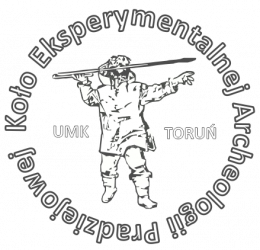These are primarily scientific experiments aiming at an attempt to reconstruct the techniques applied in primeval times as well as principles governing the production and the use of different types of objects from this period. Such process is documented on specially prepared cards. The need of taking into account many variables associated with different types of experiments made it necessary to design several kinds of them (adjusted to requirements imposed by a given project). Different parameters are taken into account when working with flint blades, different in case of experiments with tar. However, regardless of the type of research the documentation card must contain information on: the aim of the project (defined as precisely as possible), as well as the conditions and methodology of a study. Even the smallest details are of importance here. For example, prior to an experimental work with flint tool one specifies the material it is made of and precisely determines its morphology. Also, one characterizes the material in which the work is going to be conducted, including its features in detail (such as hardness, degree of dryness, preparation method etc.). Described are the conditions of an experiment. Taken into account are, among others, the profile of the performed task (e.g. cutting on both sides at 45º), working manner (e.g. with the right hand, in in the air, on a wooden stand, leather, etc.), atmospheric conditions (e.g. high humidity, heat), working rate (e.g. the amount of cuts per minute, the number of cut plants), the number and length of breaks etc. The card has also some space for a descriptive documentation, drawings and photographs of changes occurring on a tool and in the worked material. The course of experiment itself is documented here as well. The cards are catalogued within groups containing the works of particular type and in a parent collective catalogue.
The results of research carried out by SEPA are published both in our country and beyond its borders. They have appeared, among others, in „Experimentalle Archäologie in Europa” and „EuroREA – (Re)construction and Experiment in Archaeology”. The members of the Society also participate in scientific conferences.
Magdalena Wałaszewska

